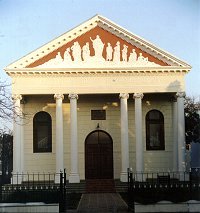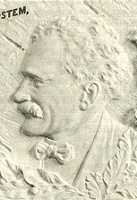| Die Stem van Suid-Afrika Uit die blou van onse hemel, uit die diepte van ons see,
Oor ons éwige gebergtes waar die kranse antwoord gee,
Deur ons vér verlate vlaktes met die kreun van ossewa
Ruis die stem van ons geliefde, van ons land Suid-Afrika.
Ons sal antwoord op jou roepstem, ons sal offer wat jy vra
:
Ons sal lewe, ons sal sterwe ons vir jou, Suid-Afrika. In die merg van ons gebeente, in ons hart en siel en gees,
In ons roem op ons verlede, in ons hoop op wat sal wees,
In ons wil en werk en wandel, van ons wieg tot aan ons graf
Deel geen ander land ons liefde, trek geen ander trou ons af.
Vaderland! ons sal die adel van jou naam met ere dra:
Waar en trou, as Afrikaners kinders van Suid-Afrika. In die songloed van ons somer, in ons winternag se kou,
In die lente van ons liefde, in die lanfer van ons rou,
By die klink van huw'liksklokkies, by die kluitklap op die kis
Streel jou stem ons nooit verniet nie, weet jy waar jou kinders is.
Op jou roep seg ons nooit nee nie, seg ons altyd, altyd ja:
Om te lewe, om te sterwe ja ons kom, Suid-Afrika. Op U Almag vas vertrouend het ons vadere gebou:
Skenk ook ons die krag, o Here, om te handhaaf en te hou
Dat die erwe van ons vaad're vir ons kinders erwe bly:
Knegte van die Allerhoogste, teen die hele wêreld vry.
Soos ons vadere vertrou het, leer ook ons vertrou, o Heer:
Met ons land en met ons nasie sal dit wel wees, God regeer. | The Call of South Africa Ringing out from our blue heavens, from our deep seas breaking round;
Over everlasting mountains where the echoing crags resound;
From our plains where creaking wagons cut their trails into the earth -
Calls the spirit of our Country, of the land that gave us birth.
At thy call we shall not falter, firm and steadfast we shall stand,
At thy will to live or perish, O South Africa, dear land.
In our body and our spirit, in our inmost heart held fast;
in the promise of our future and the glory of our past;
In our will, our work, our striving, from the cradle to the grave -
There's no land that shares our loving, and no bond that can enslave.
Thou hast borne us and we know thee. May our deeds to all proclaim
Our enduring love and service to thy honour and thy name.
In the golden warmth of summer, in the chill of winter's air,
in the surging life of springtime, in the autumn of despair;
When the wedding bells are chiming or when those we love do depart;
Thou dost know us for thy children and dost take us to thy heart.
Loudly peals the answering chorus; We are thine, and we shall stand,
Be it life or death, to answer to thy call, beloved land.
In thy power, Almighty, trusting, did our fathers build of old;
Strengthen then, O Lord, their children to defend, to love, to hold -
That the heritage they gave us for our children yet may be;
Bondsmen only of the Highest and before the whole world free.
As our fathers trusted humbly, teach us, Lord, to trust Thee still;
Guard our land and guide our people in Thy way to do Thy will. |






